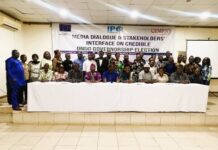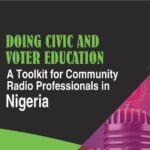Over the years, there have been growing concerns over women participation in politics, both as electorates and as position seekers.
The under-representation of women in political participation gained root due to the patriarchal practice inherent in society, much of which was obvious from the pre-colonial era to date.
Concerted efforts have been made by the government and non-governmental organizations to increase the level of participation of women in politics in line with the declaration made at the Fourth World Conference on women in Beijing, which advocated 30 percent affirmative action. In Nigeria, the extant National Gender Policy (NGP) recommended 35 percent affirmative action instead and sought for the more inclusive representation of women with at least 35 percent of both elective political and appointive public service positions respectively.
The national average of women’s political participation in Nigeria has remained 6.7 percent in elective and appointive positions, which is far below the Global Average of 22.5 percent, Africa Regional Average of 23.4 percent and West African Sub Regional Average of 15 percent. For instance, out of 36 ministerial appointments made by President Muhammadu Buhari on assumption of office in 2015, only six were women, representing 16.7 percent. In the National Assembly, women constitute 5.6 percent of members of the House of Representatives and 6.5 percent of the Senators.
Also, within the 20 years of uninterrupted democratic governance (1999-2019), Nigeria is yet to produce a female governor in any of the 36 states of the Federation.
In the build-up to the 2019 general elections, a lot of organisations and individuals came up with programmes and workshops to get women more involved in politics. Even the Independent National Election, Women Division was not left out in the effort.
These bodies and individuals also tried to get the media involved, tasking it to give equal representation to both sexes during the elections.
However, many have commended the media’s effort in the coverage of the elections, saying no gender was under-represented, while others share a different view.
Director, Voter Education Publicity, Gender and Civil Society Organisatios, Oyewole Osaze-Uzzi lamented that women issues were not on the front burner during the elections, saying, “The media concentrated on things that were not relevant to women, like marital status and family life; questions that generally journalists cannot ask men. We just had a workshop with Nigeria Union of Journalists on the issue, we reminded them of their agenda-setting role. We hope that the situation improves in the future.”
For Nigerian broadcaster, Toun Okewale of Women Radio, 91.7, Lagos, 2019 election year when compared to previous years, reportage on women was fair. “However, much more can be done. There’s the need to have media conversations on the capabilities and accomplishments of female politicians rather than her marital status, sensationalism and so on. The need for media to be deliberate and calculative in amplifying female politicians not just during but especially before elections; giving primetime and due headlines rather than sidelines mentions. This is the only way to show genuine inclusiveness as well as creating gender balance reportage. I’m hopeful that from now till 2023, primetime media reportage and visibility of female politicians across the 6 geopolitical zones will be improved,” she said.
Director, International Press Centre, Lanre Arogundade said the coverage of the 2019 elections was not as inclusive as it should have been especially against the background of the prescription by the Nigerian Media Code of Election coverage. He said, “The code says journalists should consciously reflect the views of underrepresented groups including women, youths, Persons Living With Disabilities and rural dwellers in election reports. Much of this didn’t happen. In the course of IPC’s monitoring of 12 newspapers including online ones, we discovered that from the months of June to December 2018 men were mostly used as sources of election and political stories, features, and interviews while men were also mostly mentioned.
“We realized that men constantly had over 80 percent publicity. This also meant that female candidates received less media attention than their male counterparts. The desired level of consciousness is not yet there. And our message has been that there is no political issue or story that cannot have women’s perspective as politicians, as professionals, as workers, as citizens and so on.
Prof. Funmi Mallam-Para said the reporting was fairly inclusive as “the media: print and TV carried issues of female voters, violence against female electoral officers and even activities of female Military dispatches. Even female political candidates.”
Prof. Ralph Akinfeleye lamented that the mainstream media is not gender friendly, as a lot of women who contested at state levels were never heard of. He said, “Gender issues are not exclusively for men, for instance, there is a women Radio station in Abeokuta, which did not promote women at the elections either; it concentrated on the big shots.”
He further highlighted media ownership as one of the factors leading to poor gender coverage. According to him, “Most political meetings take place at night, and women are already at a disadvantage, making them not to be very active in the political space as their male counterparts.
He stressed the need for women to blow their own trumpet. He added, “Women were not covered at the elections; the media did not separate Genesis from Exodus. For the first time, we had more women presidential candidates, and the media did not do much to promote them.”
















